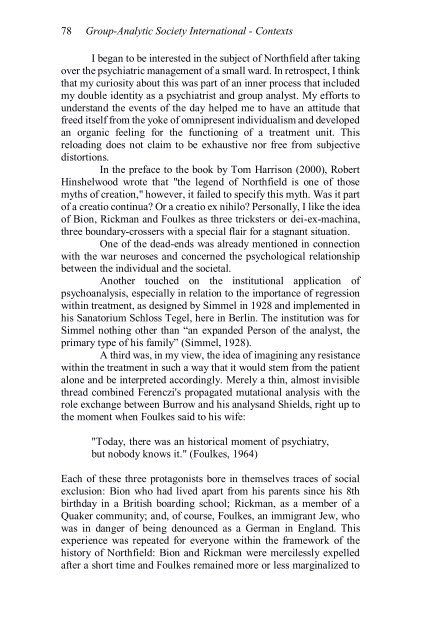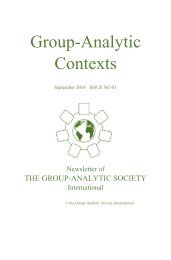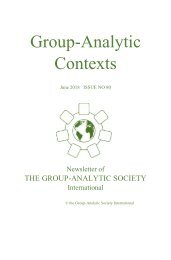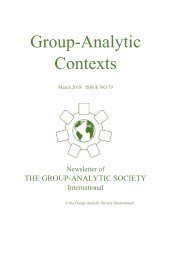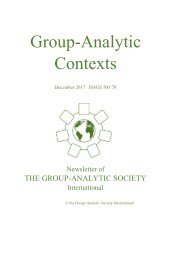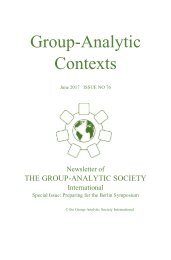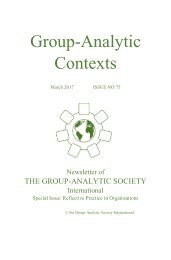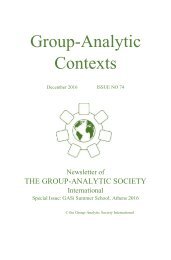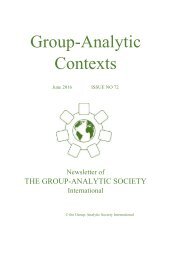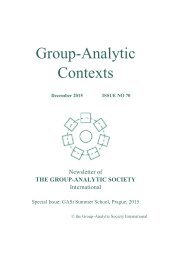Group Analytic Contexts, Issue 77, September 2017
Newsletter of the Group Analytic Society International
Newsletter of the Group Analytic Society International
You also want an ePaper? Increase the reach of your titles
YUMPU automatically turns print PDFs into web optimized ePapers that Google loves.
78 <strong>Group</strong>-<strong>Analytic</strong> Society International - <strong>Contexts</strong><br />
I began to be interested in the subject of Northfield after taking<br />
over the psychiatric management of a small ward. In retrospect, I think<br />
that my curiosity about this was part of an inner process that included<br />
my double identity as a psychiatrist and group analyst. My efforts to<br />
understand the events of the day helped me to have an attitude that<br />
freed itself from the yoke of omnipresent individualism and developed<br />
an organic feeling for the functioning of a treatment unit. This<br />
reloading does not claim to be exhaustive nor free from subjective<br />
distortions.<br />
In the preface to the book by Tom Harrison (2000), Robert<br />
Hinshelwood wrote that "the legend of Northfield is one of those<br />
myths of creation," however, it failed to specify this myth. Was it part<br />
of a creatio continua? Or a creatio ex nihilo? Personally, I like the idea<br />
of Bion, Rickman and Foulkes as three tricksters or dei-ex-machina,<br />
three boundary-crossers with a special flair for a stagnant situation.<br />
One of the dead-ends was already mentioned in connection<br />
with the war neuroses and concerned the psychological relationship<br />
between the individual and the societal.<br />
Another touched on the institutional application of<br />
psychoanalysis, especially in relation to the importance of regression<br />
within treatment, as designed by Simmel in 1928 and implemented in<br />
his Sanatorium Schloss Tegel, here in Berlin. The institution was for<br />
Simmel nothing other than “an expanded Person of the analyst, the<br />
primary type of his family” (Simmel, 1928).<br />
A third was, in my view, the idea of imagining any resistance<br />
within the treatment in such a way that it would stem from the patient<br />
alone and be interpreted accordingly. Merely a thin, almost invisible<br />
thread combined Ferenczi's propagated mutational analysis with the<br />
role exchange between Burrow and his analysand Shields, right up to<br />
the moment when Foulkes said to his wife:<br />
"Today, there was an historical moment of psychiatry,<br />
but nobody knows it." (Foulkes, 1964)<br />
Each of these three protagonists bore in themselves traces of social<br />
exclusion: Bion who had lived apart from his parents since his 8th<br />
birthday in a British boarding school; Rickman, as a member of a<br />
Quaker community; and, of course, Foulkes, an immigrant Jew, who<br />
was in danger of being denounced as a German in England. This<br />
experience was repeated for everyone within the framework of the<br />
history of Northfield: Bion and Rickman were mercilessly expelled<br />
after a short time and Foulkes remained more or less marginalized to


